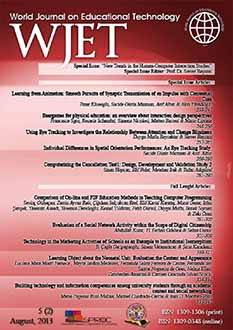Using Eye Tracking to Investigate the Relationship Between Attention and Change Blindness
Using Eye Tracking to Investigate the Relationship Between Attention and Change Blindness
Author(s): Duygu Mutlu Bayraktar, Servet BayramSubject(s): Education
Published by: Birlesik Dunya Yenilik Arastirma ve Yayincilik Merkezi
Keywords: Change Blindness; attention; change detection; eye tracking;
Summary/Abstract: Change blindness is defined as a situation that change depending on replacement of information in first presented picture with following information on empty screen is not detected. Attention makes easier for observer to detect change in focused area during change detection period. From this point of view, attention levels of individuals were focused and their effects on change blindness were determined within the scope of the study. Therefore, eye tracking data was recorded. As a result of performed One Way Variance Analysis, change blindness scores of individuals show significant differences according to attention levels (high-medium-low). When performed Post-hoc test was evaluated, it was seen that individuals with high attention levels detected changes on screen more than individuals with medium and low attention levels. According to heat map and scan path analysis obtained from eye tracking results, it seems that individuals focus on the most distinct objects onscreen and they primarily search for change in the most salient object. In addition, it is seen that individuals with high attention levels focus on change areas more than individuals with medium and low attention levels.
Journal: World Journal on Educational Technology: Current Issues
- Issue Year: 5/2013
- Issue No: 2
- Page Range: 257-265
- Page Count: 9
- Language: English

